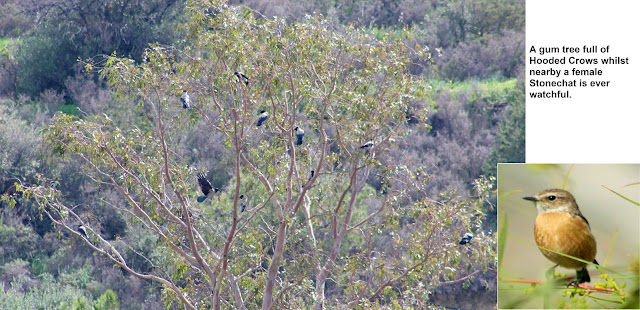Out
& About
Spring
is here at last. I don't know about you but it seems a lot longer
than thirteen weeks since the winter solstice. One thing about spring
is that life is so abundant that you don't have to go far to look for
it. Come with me into the olive grove next door and I'll show you.
Absolutely bursting with blooms: Poppies, Pimpernels, Mallow and
Medicago, Shepherd's Needles and Vetch. I can see at least fourteen
different flowers from here but the one I'm particularly interested
in today is the ubiquitous Garland Daisy as they really attract the
insects. Look, we've got a Mirid Bug, a little black Crabronid wasp,
a hoverfly and three different beetles. Not a bad little haul.
Now,
I need your help. As I was coming back from Ierapetra on Saturday
(March 23rd)
I stopped off at the beach to have a look at the pink carpet of
Catchfly that adorned the upper levels and I found myself surrounded
by hundreds of Painted Ladies. These amazing little butterflies
migrate from Africa to northern Europe but not usually in such
quantity. I have had reports in of 'huge
numbers counted over Israel and Cyprus' and also Rhodes and Nisyros.
Locally they have
been spotted from Ierapetra to Agios Fotia but not as far as Makry
Gialos. So, keep your eyes peeled and please let me know of any
sightings of large numbers either here on Crete or elsewhere in
Europe as I am part of a project that has been monitoring their
migration. * Also, in the weeks to come, look out for large numbers
of their caterpillars. They are not fussy eaters and have been
recorded on over 300 different plants so they may turn up anywhere.
(Please use the comments box below – thanks).
Next,
a bit of amazing nature. Come into the garden. About three years ago
my Loquat tree gave up the ghost, it had rotted away at the base and
I found it lying forlornly on the ground. I decided to leave it there
as a natural part of the ecosystem. This year, however, I moved the
bird table and needed a prop so the Loquat stump was pressed into
service. As you can see, I didn't dig it into the earth, I just sort
of wedged it in place. So, you can imagine my surprise when I found
it sprouting new leaves. That is one incredible recovery.
Fieldcraft
& Foraging
Meanwhile,
I have a rocket in my pocket. Or to be more precise a few salad
Rocket leaves (or Arugula in American English); Eruca sativa
for the botanically minded. It has a lovely, peppery taste and I tend
to pick leaves from the centre of the stem. They'll need a good wash
as the Heath Snails also seem to have a liking for it and rocket can
be added to almost any savoury dish that wants pepping up but mostly
it is added to salads. Being English, for many years I thought that
salad was chopped lettuce, tomato and cucumber and spring onion if
you were feeling adventurous (in much the same way as the complete
book of English meat sauces was to be found on the back of a packet
of Bisto gravy). I also thought that salads had to be eaten cold by
law. If you pop over to Steve's Wild Kitchen you can join me in a
barbecued pork chop, baked potato with a rather tasty warm mushroom,
orange and rocket salad.
In
The Lab
I've
been spending a little time with grasshoppers recently and, although
I'm not a great proponent of pinning insects merely to decorate the
walls, occasionally one does need to get up close and personal which
can be a bit difficult when the object of interest jumps ten feet as
soon as you get within spitting distance. Finding that setting boards
cost anything between five and twenty five quid (plus VAT and
delivery) I decided to make my own. All you need is a bit of
polystyrene packaging at least 5mm thick and a Stanley knife. Cut a V
shaped groove about 4mm wide by 4mm deep and there you have it. It
may not look very professional (but there again, neither does my
pinning) but it's perfectly adequate. This, incidentally, is a
Red-winged Grasshopper, Oedipoda germanica.
- Latest Painted Lady Update
Thanks
to Ian Burry who informs me that he saw a considerable number of
Painted Ladies In Neapoli yesterday (26th March) heading
up the valley towards Selinari.
Crete
Nature Catch-up
|
||
Steve's
Books (well,
just the one at the moment)
Not
Just For Twisted Women by Steve Daniels
A light-hearted look at life through the eyes of the fairer sex. Kindle Edition 1.99 pounds sterling (or equivalent). Paperback Edition 4.99 pounds sterling (or equivalent).. Read snippets, samples and stuff at Steve's Books |
*********************************************************************
LINKS:
Share
your nature thoughts, photos and comments on Naturalists
(the
facebook page that accompanies this blog)
Explore
the region with the #CreteNature interactive Hiking
and Nature Map











